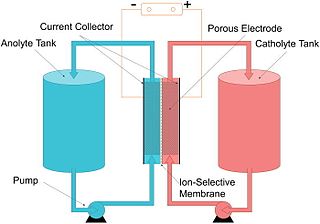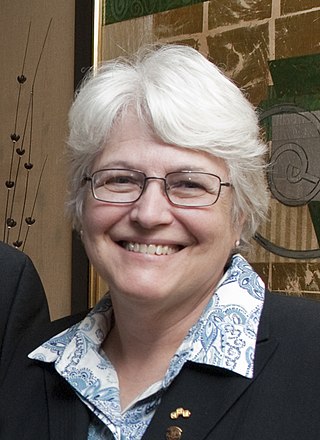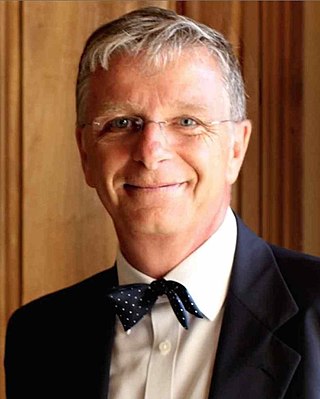Related Research Articles
Mark Sebastian Wainwright is an Australian chemical engineer and emeritus professor of the University of New South Wales, and institutional leader within the Australian academic and technological sectors. He served as seventh vice chancellor and president of the UNSW from 2004 to 2006. In 2004 he was appointed a member of the Order of Australia for services to chemical engineering as a researcher and academic, and to tertiary education. In 2007 he was awarded an honorary doctorate of science by the University of New South Wales. He was born 20 Oct.,1943.

The vanadium redox battery (VRB), also known as the vanadium flow battery (VFB) or vanadium redox flow battery (VRFB), is a type of rechargeable flow battery. It employs vanadium ions as charge carriers. The battery uses vanadium's ability to exist in a solution in four different oxidation states to make a battery with a single electroactive element instead of two. For several reasons, including their relative bulkiness, vanadium batteries are typically used for grid energy storage, i.e., attached to power plants/electrical grids.

A flow battery, or redox flow battery, is a type of electrochemical cell where chemical energy is provided by two chemical components dissolved in liquids that are pumped through the system on separate sides of a membrane. Ion transfer inside the cell occurs across the membrane while the liquids circulate in their respective spaces.
General chemistry is offered by colleges and universities as an introductory level chemistry course usually taken by students during their first year. The course is usually run with a concurrent lab section that gives students an opportunity to experience a laboratory environment and carry out experiments with the material learned in the course. These labs can consist of acid-base titrations, kinetics, equilibrium reactions, and electrochemical reactions. Chemistry majors as well as students across STEM majors such as biology, biochemistry, biomedicine, physics, and engineering are usually required to complete one year of general chemistry as well.

Esther Sans Takeuchi is a materials scientist and chemical engineer, working on energy storage systems and power sources for biomedical devices. She is also a distinguished professor at Stony Brook University and a chief scientist at Brookhaven National Laboratory. She holds more than 150 U.S. patents. “The battery was invented once and reinvented over 100 times. I don’t own the patent. The company does. It was called Greatbatch. Now it’s called Integer Corp. When you join a company, you sign over your patent rights to the company.”

Adam Heller is an Israeli American scientist and engineer. He is Chief Science Officer of SynAgile Corp. of Wilson, Wyoming, consults to Abbott Diabetes Care of Alameda, California, and is Ernest Cockrell Sr. Chair Emeritus of Engineering at The University of Texas at Austin. His 1973 paper with James J. Auborn established the feasibility of high energy density, high-voltage, non-rechargeable lithium batteries. Their 3.6-volt lithium thionyl chloride and 3.7-volt lithium sulfuryl chloride batteries remain in use in applications requiring very high energy density and a shelf life of 20 years or more.
Martina Heide Stenzel is a Professor in the Department of Chemistry at the University of New South Wales (UNSW). She is also a Royal Australian Chemical Institute (RACI) University Ambassador. She became editor for the Australian Journal of Chemistry in 2008 and has served as Scientific Editor and as of 2021, as Editorial Board Chair of RSC Materials Horizons.

'Jose H. Zagal Moya is a Chilean scientist educated at the University of Chile with postgraduate training in the United States of America with a Ph.D. degree from Case Western Reserve University, Cleveland Ohio and postdoctoral training at Brookhaven National Laboratory, Upton, New York. At present he is a Distinguished Professor, Department of Chemistry and Materials, Faculty of Chemistry and Biology, Universidad de Santiago de Chile (USACH) where he directs the Laboratory of Electrocatalysis since 1982. He got his Ph.D. in chemistry Case Western Reserve University, US (1978) and was postdoctoral fellow at Brookhaven National Laboratory, Upton, New York, in 1982. His main research efforts are focused on the fundamentals of electron transfer reactions that are relevant for energy conversion and sensors. He has contributed in the area of electrocatalysis, electrodes modified with metal macrocyclics, electrochemistry of biological molecules, the catalysis of the reduction of molecular oxygen and many other reactions of relevance, conductive polymers, electrochemical sensors and in pioneering work in the establishment of non-linear correlations between thermodynamic properties of molecular catalysts and their electrochemical reactivity. These contributions are essential in the development of non-precious metal catalysts for energy conversion devices and electrochemical sensors. [1][2][3] He also has contributed in the field of corrosion, conductive polymers and his well-known volcano correlations for the electrocatalytic properties of surface-confined molecular catalysts

Kathryn Rice Bullock was a chemist, best known for her work in developing valve-regulated lead-acid batteries. Her theoretical and statistical modeling of the electrochemistry of batteries led to better understanding of processes such as corrosion and advances in battery design. Her work has applications for hybrid and electric cars, residential fuel cell systems and solar energy storage. Kathryn Bullock has published over 60 technical papers and holds at least 11 U.S. patents. She served as vice-president of the Electrochemical Society in 1992 and as president from 1995 to 1996. Bullock died on May 17, 2021, from Alzheimer's Disease.

Hubert Girault (born 13 February 1957 in Saint-Maur-des-Fossés, France) is a Swiss chemist and is Emeritus Professor at the École Polytechnique Fédérale de Lausanne (1992-2022). He was the director of the Laboratoire d'Electrochimie Physique et Analytique, with expertise in electrochemistry at soft interfaces, Lab-on-a-Chip techniques, bio-analytical chemistry and mass-spectrometry, artificial water splitting, CO2 reduction, and redox flow batteries.
The Castner Gold Medal on Industrial Electrochemistry is an biennial award given by the Electrochemical Technology Group of Society of Chemical Industry (SCI) to an authority on applied electrochemistry or electrochemical engineering connected to industrial research. The award is named in honor of Hamilton Castner, a pioneer in the field of industrial electrochemistry, who patented in 1892 the mercury cell for the chloralkali process. Castner was an early member of SCI.

Robert Mark Wightman is an electrochemist and professor emeritus of chemistry at the University of North Carolina at Chapel Hill. He is best known for his work in the areas of ultramicroelectrodes, electrochemistry, and neurochemistry. One of Wightman's most notable achievements is the development of the ultramicroelectrode and microelectrode voltammetry. At the same time as Wightman's innovations, the microelectrode was developed independently by Martin Fleischmann at the University of Southampton. In 2011, Wightman had the 192nd highest h-index, 74, of any living chemist. As of 2018, Wightman was an author of over 390 papers and had an h-index of 103.
Susan Nan Coppersmith is an American condensed matter physicist. Formerly the Robert E. Fassnacht Professor of Physics and Vilas Research Professor in the Department of Physics at the University of Wisconsin–Madison, she moved in 2018 to the University of New South Wales.
Shelley D. Minteer is an American academic and chemistry professor at the University of Utah. Minteer field of study focuses on the interface between biocatalysts and enzyme-based electrodes for biofuel cells and sensors.
Judy Agnes Raper is an Australian chemical engineer and was previously Deputy Vice-Chancellor for Research and Innovation at the University of Wollongong. She has served as a National Science Foundation Director and led the Atomic Energy Research Establishment. She has been Dean & CEO of TEDI-London, a new engineering higher education provider since its incorporation in June, 2019.
Viola Ingrid Birss is a Professor of Chemistry at the University of Calgary. She works on electrochemistry and the development of nanomaterials for sustainable energy and sensing applications. She has demonstrated a metal oxide perovskite that can be used as the air and fuel electrode in solid oxide fuel cells, as well as creating nanoporous carbon scaffolds to be used in batteries and capacitors.
Susan A. Odom was a Professor of Chemistry at the University of Kentucky who developed redox active organic compounds for energy storage applications.

Arthur Rosenheim was a German chemist. His main work was on heteropolymetalate, colloids and complex ion chemistry.
The Iron Redox Flow Battery (IRFB), also known as Iron Salt Battery (ISB), stores and releases energy through the electrochemical reaction of iron salt. This type of battery belongs to the class of redox-flow batteries (RFB), which are alternative solutions to Lithium-Ion Batteries (LIB) for stationary applications. The IRFB can achieve up to 70% round trip energy efficiency. In comparison, other long duration storage technologies such as pumped hydro energy storage provide around 80% round trip energy efficiency.
Elod Lajos Gyenge is a professor of Chemical and Biological Engineering at the faculty of Applied Science in University of British Columbia in Vancouver, BC, Canada. He is also an associate member of the Clean Energy Research Center of UBC Vancouver campus. Elod Gyenge has been nominated for several teaching and research awards including Japanese Society for Promotion of Science (JSPS) Fellowship at Osaka University and the recipient of the distignshuied Elisabeth and Leslie Gould Endowed Professorship at UBC from 2007 to 2014. His research has been toward development of electrochemical systems such as fuel cells, batteries and electrosynthesis systems. He is also an appointed professor in the engineering school of Osaka University in Japan.
References
- ↑ M. Rychcik and M. Skyllas-Kazacos, J. Power Sources, 22 (1988) 59–67
- ↑ "Discovery and invention: How the vanadium flow battery story began". Energy Storage News. 18 October 2021. Archived from the original on 18 October 2021.
- 1 2 SKYLLAS-KAZACOS, Maria - Member of the Order of Australia (AM), 26 January 1999, It's an Honour
- ↑ "Emeritus Professor Maria Skyllas-Kazacos". research.unsw.edu.au. UNSW Research. Retrieved 28 March 2018.
- 1 2 3 4 5 6 Hooker, Claire (2000). "Professor Maria Skyllas-Kazacos, chemical engineer". Interviews with Australian Scientists. Australian Academy of Science. Retrieved 7 April 2018.
- ↑ "Skyllas-Kazacos, Maria (1951-)". People and organisations. trove.nla.gov.au. Retrieved 27 March 2018.
- 1 2 3 4 5 Keashly, Laurelle. "Maria Skyllas Kazacos, inventor of VRB technology in profile". www.vanadiumcorp.com. VanadiumCorp Resource Inc. Retrieved 7 April 2018.
- ↑ Walker, Rosanne (5 February 2010). "Skyllas-Kazakos, Maria". Biographical entry. Encyclopedia of Australian Science. Retrieved 28 March 2018.
- ↑ Skyllas-Kazacos, Maria (June 1983). "Electrodeposition of CdSe and CdSe+CdTe thin films from cyanide solutions". Journal of Electroanalytical Chemistry and Interfacial Electrochemistry. 148 (2): 233–239. doi:10.1016/S0022-0728(83)80399-4.
- ↑ Prifti, Helen; Parasuraman, Aishwarya; Winardi, Suminto; Lim, Tuti Mariana; Skyllas-Kazacos, Maria (19 June 2012). "Membranes for Redox Flow Battery Applications". Membranes. 2 (2): 275–306. doi: 10.3390/membranes2020275 . PMC 4021890 . PMID 24958177.
- ↑ "Emeritus Professor Maria Skyllas-Kazacos". Engineering. University of New South Wales. 10 February 2015. Retrieved 28 March 2018.